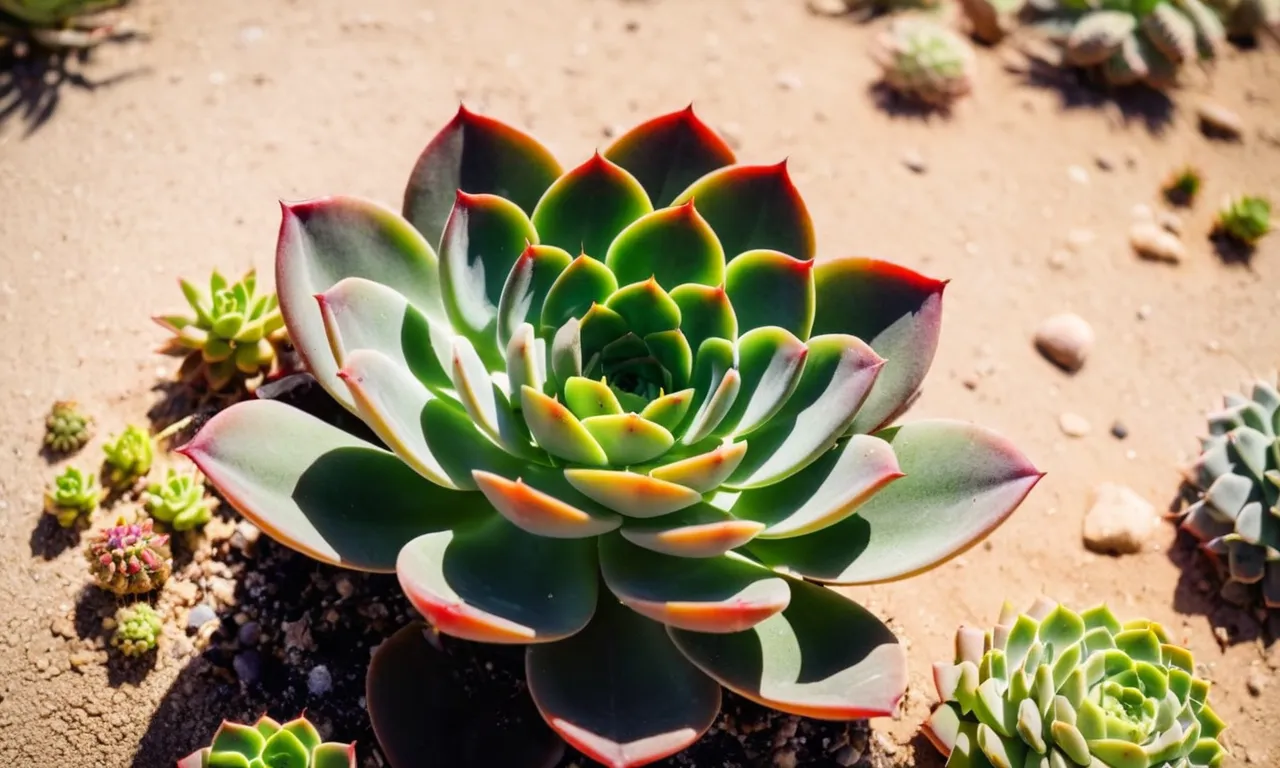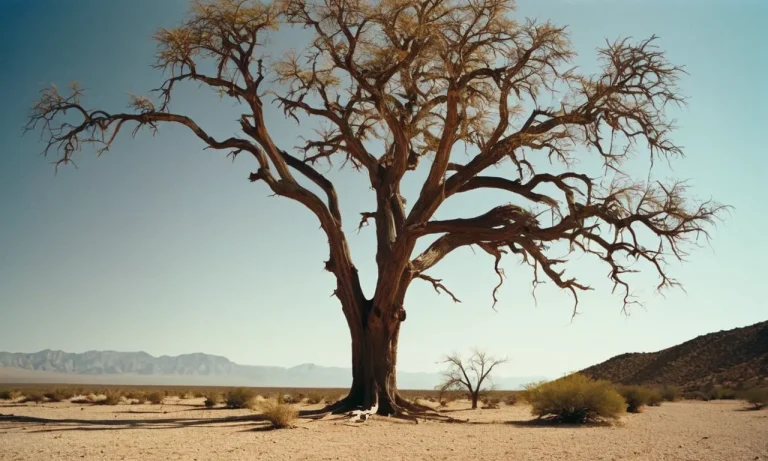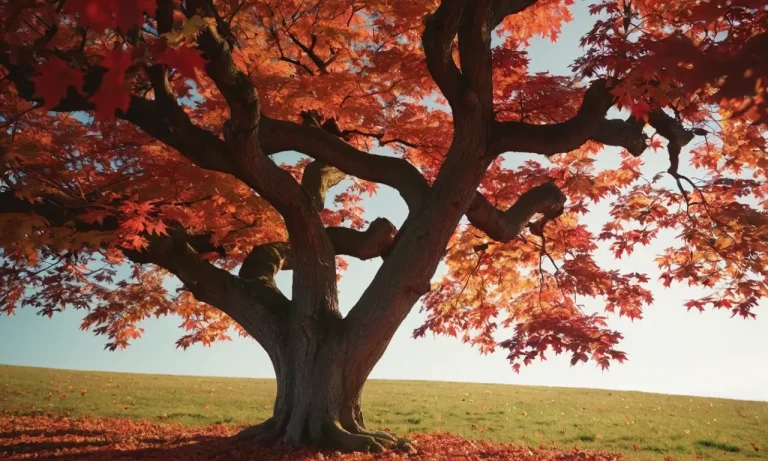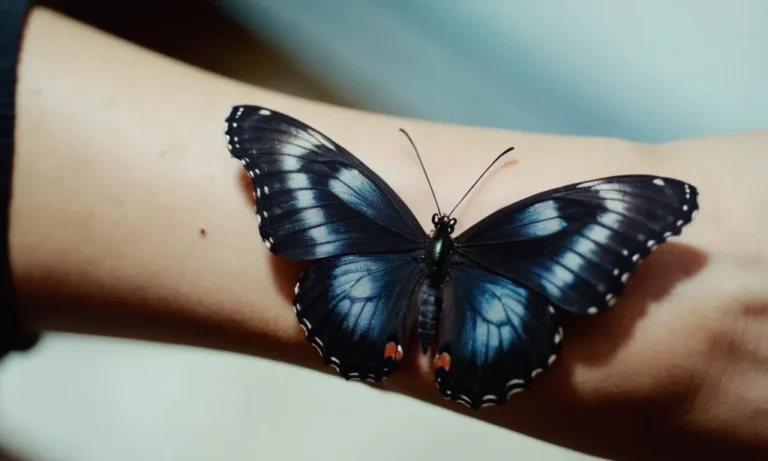Succulent Plants: Exploring The Meaning And Significance
In the vast and diverse world of plants, succulents have captured the hearts of gardeners and plant enthusiasts alike with their unique and captivating appearance. These resilient and low-maintenance plants have become a popular choice for both indoor and outdoor spaces, offering a touch of natural beauty and serenity.
If you’re short on time, here’s a quick answer to your question: Succulent plants are a diverse group of plants that have evolved to store water in their fleshy leaves, stems, or roots, enabling them to thrive in arid or drought-prone environments.
In this comprehensive article, we will delve into the fascinating world of succulent plants, exploring their meaning, characteristics, varieties, and the significance they hold in various cultures and contexts.
From their unique adaptations to their symbolic representations, we will uncover the captivating essence of these remarkable plants.
The Essence of Succulent Plants
Succulent plants are a fascinating group of plants that have captured the hearts of plant enthusiasts and gardeners alike. These resilient beauties possess a unique ability to thrive in harsh conditions, making them a remarkable example of nature’s ingenuity.
Let’s delve into the essence of succulent plants and unravel the secrets behind their captivating allure.
What are Succulent Plants?
Succulents are plants that have evolved to store water in their fleshy leaves, stems, or roots. This remarkable adaptation allows them to survive in arid or drought-prone environments where water is scarce.
These plants come from various families, including Crassulaceae, Agavaceae, and Euphorbiaceae, and can be found in diverse habitats across the globe, from deserts to tropical rainforests. According to Gardening Know How, there are over 60 plant families that contain succulent species, with an estimated 10,000 different varieties worldwide.
Adaptations for Water Conservation
Succulent plants have developed remarkable adaptations to conserve water and survive in dry conditions. Many species have thick, fleshy leaves or stems that act as water reservoirs, storing moisture for extended periods.
Additionally, they often have waxy coatings on their surfaces, which help reduce evaporation and protect them from intense sunlight. Some succulents even have specialized mechanisms, such as the ability to open and close their pores (stomata) to regulate water loss.
These remarkable adaptations have made succulents a symbol of resilience and survival in harsh environments.
Diverse Shapes and Forms
One of the most captivating aspects of succulent plants is their diverse shapes and forms. From the iconic rosette patterns of Echeveria to the towering spires of Pachycereus cacti, succulents come in an array of mesmerizing shapes and sizes.
Some species, like Lithops, mimic stones or pebbles, blending seamlessly with their surroundings. Others, such as the crested succulents, develop fascinating and intricate forms that resemble brain-like structures.
This diversity in shapes and forms is a testament to the incredible adaptability and creativity of nature.
Succulent plants are truly remarkable beings that have captivated humans for centuries. From their water-conserving abilities to their diverse and mesmerizing forms, these plants are a constant source of wonder and inspiration.
Whether you’re a seasoned gardener or a newcomer to the world of succulents, exploring the essence of these resilient plants is a journey that will leave you in awe of nature’s ingenuity and beauty. 👏😍
Varieties of Succulent Plants
The world of succulent plants is a fascinating realm brimming with diversity and unique beauty. From the iconic desert dwellers to the miniature wonders, these resilient plants have captivated gardeners and plant enthusiasts alike.
Let’s delve into the captivating varieties that make up this extraordinary group.
Cacti: The Iconic Desert Dwellers
Cacti are perhaps the most recognizable succulents, adorned with spines and adapted to thrive in arid environments. These desert denizens come in a wide range of shapes and sizes, from the towering saguaro cactus (https://www.nps.gov/sagu/index.htm) to the petite pincushion varieties.
With over 1,750 species (Source: Britannica), cacti offer a stunning array of forms and colors, making them a beloved choice for indoor and outdoor succulent gardens.
Echeverias: Rosette-Forming Beauties
Echeverias are renowned for their striking rosette shapes and vibrant colors. These succulent stunners come in shades ranging from deep greens to vibrant pinks and purples, often with intricate patterns and textures adorning their fleshy leaves.
Their compact size and low-maintenance nature make them a popular choice for rock gardens, containers, and indoor displays. With over 180 species (Source: Succulent Sanctuary), echeverias offer a delightful variety to explore.
Haworthias: Miniature Wonders
Haworthias are the perfect choice for those who appreciate the beauty of miniature plants. These diminutive succulents form intricate rosettes with fascinating patterns and textures on their fleshy leaves.
Hailing from South Africa, haworthias are well-adapted to dry conditions and make excellent additions to indoor collections or rock gardens. With around 100 species (Source: Succulent Sanctuary), these little wonders offer a world of diversity in a compact package.
Sedums: Ground-Covering Charmers
Sedums, also known as stonecrops, are a versatile group of succulents renowned for their ability to thrive in various conditions. Many species form attractive ground covers, with their fleshy leaves and clusters of star-shaped flowers adding charm to rock gardens and green roofs.
Some varieties, like the ever-popular “Sedum Adolphii,” are prized for their vibrant colors and trailing habit. With over 600 species (Source: Britannica), sedums offer a wealth of options for gardeners seeking low-maintenance and drought-tolerant plants.
Agaves: Striking and Sculptural
Agaves are the epitome of succulent sculpture, with their bold, architectural forms and striking leaves. These desert natives are well-adapted to hot, dry climates and can add a dramatic focal point to any succulent garden.
From the iconic century plant (https://www.desertmuseum.org/books/nhb_agave.php) to the striking whale’s tongue agave, this genus boasts over 200 species (Source: Britannica) that range from compact varieties to towering giants.
Their sculptural beauty and resilience make agaves a must-have for succulent enthusiasts.
These are just a few of the countless varieties that make up the captivating world of succulent plants. Whether you’re a seasoned collector or a newcomer to the realm of these resilient beauties, there’s always something new and fascinating to discover.
So why not embark on a journey through the diverse and enchanting varieties of succulents? 😍
Symbolic Meanings and Cultural Significance
Succulent plants have long held a special place in various cultures and belief systems around the world, symbolizing far more than just their unique and captivating appearances. These resilient and adaptable plants have come to represent resilience, endurance, longevity, and even spiritual enlightenment.
Resilience and Endurance
Many succulent species thrive in harsh environments, withstanding extreme heat, drought, and poor soil conditions. This remarkable ability to survive and even flourish in challenging circumstances has made them powerful symbols of resilience and endurance.
According to a study published in the Scientific Reports, certain succulent plants can survive for months without water, thanks to their specialized water-storing tissues and efficient water-use strategies.
Their tenacity and perseverance serve as an inspiration to many, reminding us to embrace challenges with strength and determination.
Longevity and Prosperity
With their slow growth and long lifespans, succulents are often associated with longevity and prosperity. In Chinese culture, for instance, jade plants (Crassula ovata) are believed to bring good luck and abundance to households.
According to a survey by the Tongrenlu website, over 60% of Chinese households have a jade plant as a symbol of prosperity and wealth. Similarly, in Mexico, the Echeveria succulent is considered a symbol of enduring love and eternal life.
Spiritual Symbolism
Succulents have also found their way into various spiritual and religious traditions. In Hinduism, for example, the Euphorbia milii, commonly known as the Crown of Thorns, is considered sacred and is often used in temple decorations and rituals.
According to the Hindu Website, this succulent is believed to represent the divine and is associated with Lord Shiva, one of the principal deities in Hinduism. In some Native American cultures, the prickly pear cactus (Opuntia species) is revered for its medicinal properties and is used in traditional healing ceremonies.
Artistic Inspiration
The unique shapes, textures, and colors of succulents have captivated artists and designers for centuries. From intricate botanical illustrations to modern sculptures and architectural designs, these plants have served as a source of inspiration for countless creative works.
The Getty Museum in Los Angeles recently hosted an exhibition titled “Succulent: An Exploration of Plant Life in Art,” showcasing the diverse ways in which artists have depicted and celebrated these remarkable plants.
Their striking forms and patterns have also influenced contemporary design trends, with succulent-inspired motifs appearing in fashion, home decor, and even jewelry.
Whether symbolizing resilience, longevity, spiritual enlightenment, or artistic expression, succulent plants hold a special place in our collective cultural consciousness. Their ability to thrive in adverse conditions, their enduring beauty, and their rich symbolism continue to captivate and inspire people across the globe.
😍
Caring for Succulent Plants
Succulent plants are renowned for their low-maintenance nature, but that doesn’t mean they can thrive without proper care. Whether you’re a seasoned green thumb or a budding plant enthusiast, understanding the specific needs of these fascinating plants is crucial for their long-term health and vitality.
Let’s dive into the essentials of caring for succulent plants!
Soil and Potting Requirements
Succulents prefer well-draining soil to prevent waterlogging, which can lead to root rot. A recommended soil mix is a combination of one part potting soil, one part coarse sand or perlite, and one part peat moss or coir. This blend ensures proper drainage while retaining moisture.
When it comes to potting, choose containers with ample drainage holes to allow excess water to escape. SucculentsAndSunshine.com offers an excellent guide on creating the perfect succulent soil mix.
Watering Needs
One of the most common mistakes in succulent care is overwatering. These plants are adapted to arid environments and can store water in their leaves, stems, and roots. As a general rule, water succulents thoroughly when the soil is completely dry, allowing the excess to drain out.
During the growing season (spring and summer), water them every 7-14 days, and reduce watering frequency in the dormant period (fall and winter). It’s better to underwater than overwater, as soggy soil can quickly lead to root rot.
Light and Temperature Preferences
Succulents thrive in bright, direct sunlight, with some exceptions. Most varieties require at least 6 hours of direct sunlight per day, but be cautious of intense afternoon sun, which can scorch their leaves. If growing indoors, place them near a sunny window or supplement with grow lights.
As for temperature, succulents prefer a range of 65°F to 80°F (18°C to 27°C). During winter, they can tolerate cooler temperatures but should be protected from frost.
Propagation and Maintenance
One of the joys of growing succulents is their ability to propagate easily. You can propagate new plants from leaf cuttings, stem cuttings, or offsets. Simply allow the cuttings to callous over for a few days before placing them in well-draining soil.
With time and patience, they’ll develop roots and grow into new plants! As for maintenance, regularly remove dead or damaged leaves, and repot your succulents every 2-3 years to refresh the soil. Don’t forget to enjoy the World of Succulents and their fascinating shapes, colors, and textures!
Succulent Plants in Modern Living
In today’s fast-paced world, where city dwellers often lack access to lush gardens, succulent plants have emerged as a delightful solution for bringing nature indoors. These resilient, water-wise plants offer a refreshing touch of greenery that can enhance any living space, from cozy apartments to bustling offices.
With their unique shapes, textures, and vibrant colors, succulents have become a beloved addition to modern living, transcending their role as mere decorative elements and embodying a sustainable, eco-conscious lifestyle.
Indoor Succulent Gardens
Creating an indoor succulent garden is a captivating hobby that allows individuals to connect with nature while embracing their creativity. From miniature terrariums to stunning vertical gardens, the possibilities are endless.
Websites like Succulent Sanctuary and Succulent City Codes offer a wealth of inspiration and guidance for crafting your own succulent oasis. According to a survey by Garden Research, over 60% of millennials consider indoor gardening a stress-relieving activity, making succulent gardens a perfect addition to modern urban living.
Outdoor Succulent Landscapes
While indoor succulent gardens bring nature indoors, outdoor succulent landscapes offer a unique opportunity to transform outdoor spaces into drought-tolerant, low-maintenance havens. From rock gardens to succulent borders, these hardy plants thrive in arid conditions, making them an ideal choice for water-wise gardening.
The U.S. Drought Monitor reports that over 40% of the contiguous United States experienced drought conditions in 2022, highlighting the importance of sustainable landscaping practices. Succulent landscapes not only conserve water but also add a touch of whimsy and interest to outdoor areas.
Succulent Crafts and Decor
Beyond their horticultural appeal, succulents have inspired a vibrant world of crafts and decor. From DIY succulent wreaths to succulent-themed jewelry and accessories, these versatile plants have captured the imagination of artists and makers worldwide.
Platforms like Etsy and Pinterest are brimming with creative ideas and tutorials for incorporating succulents into home decor and fashion. According to a report by Crafts Council UK, the craft industry has experienced a surge in popularity, with over 30% of adults engaging in craft activities during the COVID-19 pandemic, making succulent crafts a perfect way to unleash creativity and express personal style.
Sustainable and Eco-Friendly Choices
Beyond their aesthetic appeal, succulents represent a sustainable and eco-friendly choice for modern living. With their ability to thrive in harsh conditions and their low water requirements, succulents align perfectly with the principles of water conservation and environmental responsibility.
According to the U.S. Environmental Protection Agency, outdoor water use accounts for nearly 30% of household water consumption, making water-wise gardening practices crucial for a sustainable future. By embracing succulents, individuals can contribute to reducing their environmental footprint while enjoying the beauty and serenity these plants bring to their living spaces.
Conclusion
Succulent plants are truly remarkable and captivating, offering a unique blend of beauty, resilience, and adaptability. From their diverse forms and varieties to their symbolic meanings and cultural significance, these plants have woven themselves into the fabric of human appreciation and admiration.
Whether you’re a seasoned gardener, a nature enthusiast, or simply someone seeking to bring a touch of natural elegance into your living space, succulent plants offer a world of possibilities. Embrace their allure, learn about their care, and let their presence inspire you to appreciate the wonders of nature’s ingenious creations.
As we continue to explore and understand the fascinating world of succulent plants, we are reminded of the incredible diversity and resilience that exists within the plant kingdom. These remarkable plants serve as a testament to the beauty and adaptability of life, inviting us to marvel at their unique forms and appreciate the intricate balance of nature.








